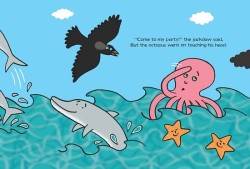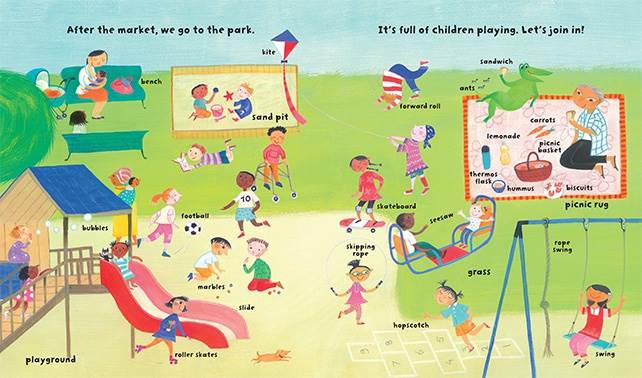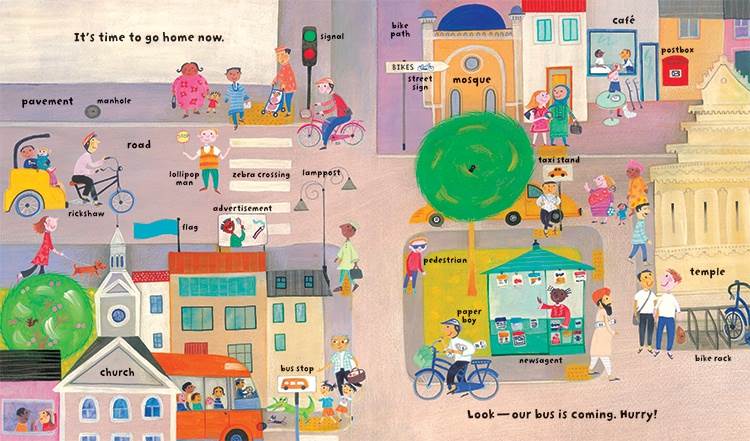Naturally inclusive Picture Books
Published on: 03 February 2017 Author: Alex Strick
BookTrust Disability Consultant Alex Strick offers publishers and illustrators eight top tips on making picture books more inclusive.

This month's Bookmark book of the month is a powerful example of how a picture book can create an effortlessly inclusive backdrop and reflect our diverse community whilst avoiding either a forced or tokenistic approach.
Inspired by this book, in this blog I thought I'd share a few ideas on including disabled characters naturally and positively, and avoiding some of the potential pitfalls.
Think beyond wheelchairs
The international symbol for disability is a wheelchair, so it's hardly surprising it is the first thing that comes to mind when we picture disabled characters. In fact less than 8% of disabled people in the UK are wheelchair users. There are so many forms of disability which are underrepresented - in fact some have seldom (if ever) appeared in a children's book - isn't it time that they did? I'll go on to highlight some specific suggestions in this blog.
Sensory impairment
There was a time (not long ago) when glasses were only used to indicate intellectual or nerdy characters. Thankfully times have started to change and books are rightly showing a more accurate proportion of children and adults sporting cool glasses. Why not also consider including a child wearing a colourful eye patch? Or perhaps include a child with strabismus (a 'squint') or ambloyopia ('lazy eye') without comment? Likewise, hearing aids are appearing more often in illustrations. With deafness, it's important to keep in mind that it is a broad spectrum and to be aware of the wide range of modern hearing aids and cochlear implants available.

Face and skin
How often have you seen someone with facial disfiguration, cleft palate, eczema or a birthmark in a children's book? This is still a particularly underrepresented area in books, but particularly in those for younger readers. Including a child with a birthmark or some kind of skin disorder doesn't have to be presented as an 'issue' but just something which appears naturally, as it might well do in any classroom or nursery. And it's not as difficult as you might think - there's plenty of reference material out there to help.
Mobility equipment
If you do feature a wheelchair, remember that there are many different types of wheelchair - not just the traditional (and rather clunky-looking) chairs some people might first picture. Remember there are also many other different forms of mobility equipment, including walkers and leisure equipment like adapted trikes and bikes.
Don't push me
Think about the way you present a disabled person and the messages you give out. For example, if you feature a wheelchair, don't automatically assume you also need to feature someone behind it, holding the handles and pushing its user around - actually many wheelchairs are self-propelled or electrically powered. Show the wheelchair-user in control and give them independence.
Complex needs
Characters with profound and multiple difficulties have rarely appeared in children's books, and where they have, it is generally in an issue book or a book 'about' disability. Surely such children can also be included equally and without comment alongside their peers, with just a bit of research and thought.

Invisible impairments
You might also like to think about communication difficulties, the autistic spectrum, dyslexia, dyspraxia, epilepsy, diabetes, ADHD or mental health issues. These can often be described as invisible, and therefore considered difficult or even impossible to include in an illustration. In fact if we think clever, there are all sorts of ingenious ways of acknowledging them visually to ensure all children are included. For starters, how about showing a child using a communication aid to talk to family or friends?
Autistic spectrum disorders
Conditions like Asperger's Syndrome have started to appear more often in older fiction, but again there is also potential for picture books to acknowledge the autistic spectrum. There are simple and valuable ways in which books can help challenge stereotypes and assumptions. For example, they can show that people of all ages and both genders have conditions like Asperger's Syndrome and they can help illustrate the fact that autism really is a 'spectrum', taking many different forms and involving a multitude of different experiences.
All children have the right to find themselves in the books they read, and it should be possible to ensure they are. This list has barely scratched the surface, but hopefully it's prompted a few initial ideas. The key to making it work is doing one's research - and in fact there is a wealth of reference material out there to help us get it right.
Topics: Picture book, Bookmark, Disability, Inclusive, Features





